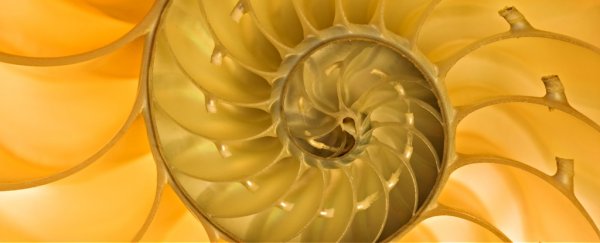In certain circles, including some of the ones I travel in, there's great excitement about yesterday's date. We won't see its like again for another century.
What makes it so special? The date – 1/6/181 – lines up with the first four digits of the golden ratio, a mathematical constant that's roughly equal to 1.618 and is commonly denoted by the Greek letter phi, which looks a bit like the letter "p" but with an extra loop on the left-hand side of the vertical axis.
So let's celebrate Phi Day by considering some of the wonderful things the golden ratio has to offer.
The golden ratio is the proportion that arises when we cut a line into two parts so that the ratio of the whole length to the long part is equal to the ratio of the lengths of the two parts.
Many find those sorts of proportions aesthetically pleasing: Le Corbusier, for example, based his system of architecture on them ; they may also have figured into the Parthenon. And mathematically, the golden ratio is cool because it is the only positive number such that you get its square if you add 1 to it.2
But that's not all! The golden ratio has been found in nature everywhere from nautilus shells to magnetic resonance at the atomic scale. Perhaps prefiguring this, Luca Pacioli – a Renaissance-era forefather of modern accounting – ascribed divine significance to the golden ratio. (On a more earthly plane, the golden ratio co-starred alongside Donald Duck in the 1950s.)
The golden ratio is also linked to a famous sequence attributed to Fibonacci: If you start with 1 and 1, and generate a series of numbers by adding the most recent two together to get the next, you end up with:
1, 1, 2 (= 1+1), 3 (= 1+2), 5 (= 2+3), 8 (= 3+5), 13, 21, 34, 55, 89, 144, 233, 377….
This sequence crops up in nature as well – in sunflowers and pinecones(and even in lemonade!?).
There's gold buried there, too: as we continue the sequence on and on, the ratio of consecutive terms approaches the golden ratio (for example, 377/233 is roughly 1.61803).
So how should you celebrate a golden day like this? It's probably too late to plan a trip to the Golden State. But you can still chow down on some golden delicious apples, Golden Grahams or golden rice. Or you could just listen to some golden oldies.
Whatever you do, make it count. There won't be another day this golden until 2118.3
1 Admittedly, I pulled some sleight-of-hand there by switching to European date conventions, with the day preceding the month. But the study of the golden ratio has European roots. And besides, the Phi Day under the American convention – Jan. 6, 2018 — was too close to other mathematical excitement.
2 And indeed, 1 + 1.618 = 2.618 is just about 1.618 X 1.618.
3 Math geeks like me do have a bit more fun coming up this year, however, with the last e Day of the century on July 2.
2018 © Bloomberg
This article was originally published by Bloomberg.
